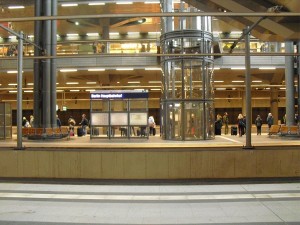All Trains Lead To Bewitching Bratislava
It may be hard to imagine now, but a hundred years ago trains were the de rigueur mode of transportation. They were luxurious, extravagant affairs, where men in smart suits smoked handcrafted pipes while women in elegant dresses sipped tea.
Times sure have changed, haven’t they? In the age of hustle and bustle, budget airlines and instant everything, the excitement and romance of the railways of old seems, well, quaint.
But the magic of that bygone age can still be recaptured, if only for a little while. All one has to do is hop on the EuroCity 175 from Berlin, for a trip back in time through the mountains and over the hills, to the Slovakian capital of Bratislava.
OK, so it may not be as chic a destination of fellow Danube darlings Budapest and Vienna. And it was rather crudely depicted in the 2004 film EuroTrip as a drab post-Soviet wasteland (never mind the fact that the movie was not even filmed in Slovakia) where a single nickel could pay for the opening of an entire hotel. The critics couldn’t be more wrong.
Majestic Baroque palaces, churches crowned by onion spires, cobblestone lanes, cozy cafes, and quirky museums in shades of marigold and lavender proliferate in this relatively compact city that has lured many renowned composers, including Mozart, Beethoven and Joseph Haydn. It oozes charm, with the mystery that only a “hidden” city oft-overlooked can bring.
But how should one get there — by plane? M. R. Štefánik Airport has regular connections to the United Kingdom, Italy, Norway and Russia. What about traveling by car? Several major highways converge from Austria, Hungary and the Czech Republic. Or maybe the way to go is by train? Ah, that’s the idea — especially when the carriage is a EuroCity coach.
EuroCity (abbreviated as “EC”) is a train category within the European intercity rail network. In contrast to lower-level InterCity trains, for a train to be dubbed “EuroCity,” it must meet several stringent requirements, including:
• It must travel through two or more countries.
• All cars must be air-conditioned.
• The train can only stop at major cities.
• Stops can last no more than five minutes, though in exceptional cases up to 15 minutes.
• Food and beverages must be available onboard.
• Conductors speak at least two languages, one of which must be English, French or German.
• The train must maintain an average speed (including stops) above 90 kilometers per hour (56 miles per hour).
With such standards in place, a relaxing overland voyage, far removed from the madcap claustrophobia that’s the norm on most means of transport in the German capital, is guaranteed. This was by far the furthest journey by rail I’d ever taken, and with the memory of a 24-hour bus trip through eastern Turkey and Georgia a year ago still somewhat fresh in my mind, I was loathe to repeat the experience.
The brisk morning air forming little clouds of vapor with every exhalation, the “Jeszenszky János” — named after the Slovak physician, politician and philosopher of the same name (Anglicized as “Jan Jesenius”) — arrived at Berlin Hauptbahnhof precisely on time. Stepping into the mostly empty carriage, the all-encompassing warmth of a heating system could not be understated. A little placard greeted me on my seat with the name of the train and the times of arrival and departure at every stop. Originally, all EuroCity trains carried names — and many still do — in a continuation of the practice that started with the luxury trains of the 19th and early 20th centuries. We were to head to Bratislava, of course, with stopovers in such cities as Dresden, Prague and Brno. The whole trip would take almost exactly nine hours.
With the hills of the former East Germany rolling past, I leaned back and sunk myself into Norwegian journalist Åsne Seierstad’s One Hundred And One Days: A Baghdad Journal. It wasn’t the Scandinavian version of the Great American Novel, but the harrowing account of one reporter’s adventures in Iraq during the fall of Saddam Hussein was nonetheless stimulating as the occasional light rain pattered against the windows.
As the hours passed by and Germany became the Czech Republic, a feeling of discomfort slowly churned within my midsection. Stomach cramps? No. These were hunger pangs, and there was only one cure.
The world’s first restaurant cars were built at the end of the 1800s, aiming to save time on long distance journeys when trains would otherwise have to stop at station dining rooms. Quality fare served amidst upholstered furniture and handcrafted marquetry came standard, as did alcoholic beverages that in contemporary times are usually reserved to only the most upscale establishments. Some trains even had their own signature drink. The famous Orient Express boasts the Agatha Christie — made with one ingredient from every country along the route from Paris to Istanbul (though the recipe is kept secret) — as its claim to alcoholic fame, and admittedly the EuroCity trains have no such spirituous specialties besides canned beers and a basic wine list.
(Article continued on next page)

